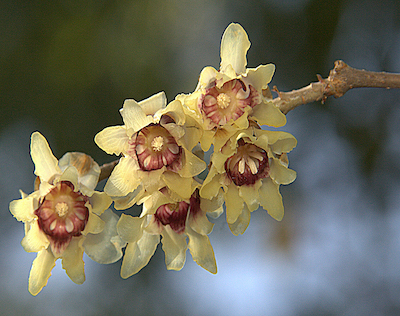Order: Laurales
Family: Calycanthaceae
General Overview: Chimonanthus praecox, also known as wintersweet, is a deciduous shrub. It is native to China and is widely distributed throughout the country.
Morphological Features: A robust deciduous shrub that attains a height of 4 m, featuring an erect trunk and leaves measuring 5–29 cm in length and 2–12 cm in width. Notably, its pendant flowers emit a strong fragrance and appear in winter (typically between November and March in the UK) on exposed stems. These flowers boast 15-21 tepals in yellow or pale green-yellow hues, with the inner ones often exhibiting purplish-red pigments.
Biological Characteristics: In traditional Chinese medicine, the flowers of Chimonanthus praecox have been used to treat various ailments, including respiratory problems, arthritis, and menstrual disorders. Its essential oils are also used in aromatherapy for their calming and mood-enhancing properties. Chimonanthus praecox is also a popular ornamental plant, valued for its attractive winter flowers and fragrant blooms. It is commonly used in gardens and parks, and has been introduced to other parts of the world for its ornamental value. Overall, Chimonanthus praecox is a valuable shrub with a range of traditional uses and ornamental value. Its cultural significance and historical use in traditional Chinese medicine also make it an important part of Chinese culture and heritage.

